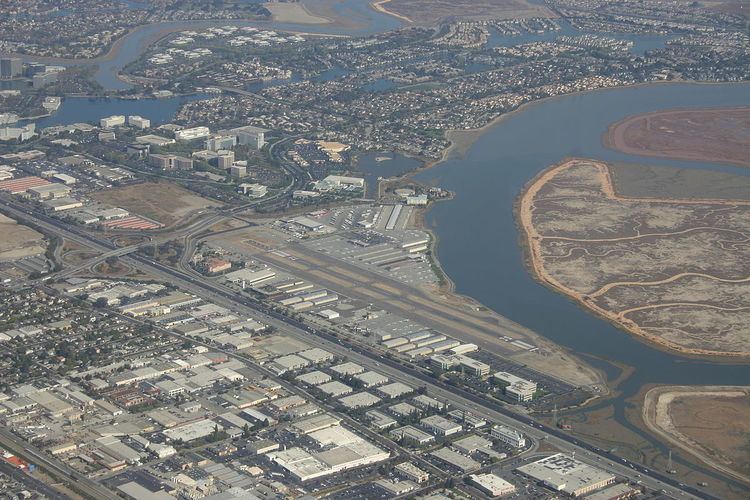Airport type Public 12/30 2,600 792 Asphalt Code SQL Phone +1 650-573-3700 | Elevation AMSL 5 ft / 2 m 2,600 792 Aircraft operations 155,273 Elevation 1.5 m Serves San Carlos | |
 | ||
Address 620 Airport Way, San Carlos, CA 94070, USA Profiles | ||
San Carlos Airport (IATA: SQL, ICAO: KSQL, FAA LID: SQL) is two miles northeast of San Carlos, California, in San Mateo County, California. The FAA's National Plan of Integrated Airport Systems (NPIAS) classifies San Carlos as a reliever airport for San Francisco International Airport.
Contents
- History
- Facilities
- Origin of SQL airport code
- Experimental Aircraft Association
- 1999 Proposed Runway Extension
- References
The airport is off U.S. Route 101. The airport is home to Civil Air Patrol West Bay Composite Squadron 192. Next to the airport is the Hiller Air Museum.
History
The San Carlos Flying Field was established during World War I by J. Pauling Edwards on a five-acre field south of Cordilleras Creek. San Carlos' first pilot's certificate was issued on July 10, 1917 to Lieutenant Prince.
In 1923, the airfield was taken over by the Cooley family. Charles P. Cooley was the primary flight instructor in San Carlos at the time, after returning from battle. The airport itself was legally operated by Cooley's father, Frank S. Cooley. On July 12, 1940, a fire destroyed the main hangar and twelve aircraft. The family then vacated the property in 1935, closing the airport and the flight school and moving their operations to a new airfield near today's Twin Dolphin Drive in San Carlos. By March 1950, the airfield had a 200 ft by 2100 ft runway and a building for various industries on the airfield. However, the Cooley family soon regarded the airport as being inadequate due to its proximity to the Phelpes Slough and Steinberger Slough and poor ground conditions for a suitable runway. They opened another airfield at the present location of the San Carlos airport. By March 1952, the Cooley family transferred ownership of the airfield to Mr. Francis Michaud, who renamed it San Carlos-Belmont Airport. Many repair and administrative buildings were added along with plans to expand the runway up to 7000 ft in length. In 1957, the airport was renamed as San Mateo Country Airport, Inc. Ownership was also split between Michaud, the Piombo Construction Company and six other parties.
Facilities
San Carlos Airport covers 110 acres (45 ha) at an elevation of 5 feet (2 m). Its one runway, 12/30, is 2,600 by 75 feet (792 x 23 m) asphalt.
A plan to lengthen the runway by 400 feet was quelled by neighbors in 1999. Aircraft with gross weight in excess of 12,500 lb (5,670 kg) are prohibited.
San Carlos Airport is home to over 30 aviation related businesses. Facilities and FBOs at KSQL include: Bay Aerial Helicopter Service, Fly Bay Area, JATO Aviation, Rabbit Aviation Services, Surf Air, Zanette Aviation Insurance, West Valley Flying Club, Diamond Aviation Charter, and the San Carlos Flight Center.
In 2007 the airport had 155,273 aircraft operations, average 425 per day: 98% general aviation, 2% air taxi and <1% military. 372 aircraft were then based at this airport: 86% single-engine, 11% multi-engine, <1% jet and 3% helicopter.
Origin of SQL airport code
Given its proximity to the headquarters of the Oracle Corporation, a maker of database software, some have speculated that the airport code of SQL is a humorous reference to this large neighbor; in databases, SQL stands for Structured Query Language. In fact the airport was SQL years before June 16, 1977, the date of incorporation of Software Development Laboratories which became the Oracle corporation.
Experimental Aircraft Association
The Experimental Aircraft Association (EAA) has a local chapter at San Carlos Airport. EAA Chapter 20 has about 50 members as of 2010.
1999 Proposed Runway Extension
In 1999 a proposal was given to extend the runway into the marsh before runway 30. The proposal caused trouble in Redwood Shores and Foster City, where critics complained about noise. Despite promises by San Mateo County officials, opponents felt a longer runway would lead to bigger and noisier planes, in particular, more corporate aircraft.
